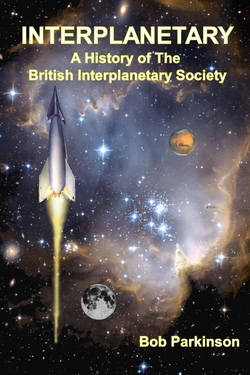Centauri Dreams
Imagining and Planning Interstellar Exploration
A Holiday Thought Looking Ahead
I want to send along best wishes for the season to all of you. Centauri Dreams started as a book and became a study guide for me as I tried to keep up with ongoing developments in deep space research. But turning the site into a community, which I did in 2005 by adding comments, has been what really made it go, as I’ve continued to learn from the discussions between readers, finding new resources and different insights I would never have achieved on my own. So thank all of you for this continuing gift, and may this holiday season be the prelude to great discoveries ahead.

Stellar Flares as an Aid to Life Detection
The interesting transient associated with Proxima Centauri and monitored by Breakthrough Listen reminds us of a key fact about red dwarf stars and the planets around them. Such stars, especially in their youth, are prone to high flare activity, meaning violent, unpredictable emissions that can deplete atmospheric gases like ozone. Even if the atmosphere survives strong stellar winds, the loss of ozone can lead to high levels of ultraviolet radiation reaching the surface and compromising any life there.
That stellar flares can be dramatic is captured in the image below, showing a filament eruption from the Sun and accompanying solar flares (credit: NASA/GSFC/SDO). As striking as the image is, it depicts activity on an older star less prone to strong flare activity than younger, smaller stars. We’re also fortunate in having the shield offered by Earth’s magnetic field, which can deflect the worst of the solar wind. Our G-class Sun lets us orbit at a comfortable distance, but planets in the habitable zones of M-class dwarfs are in tight orbits. Proxima Centauri b, for example, orbits its primary in a scant 11 days at a distance of 0.0485 AU.
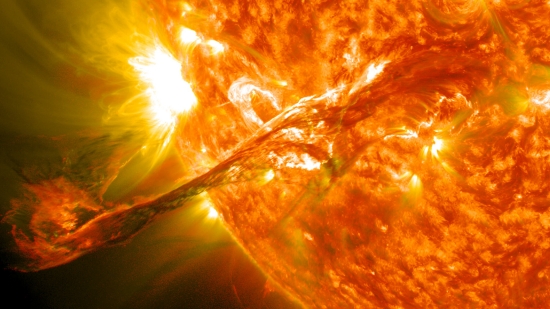
This may or may not be a deal-breaker for life, given evolutionary change that may force adaptations we can only imagine, but it certainly creates stark conditions for its formation. Even so, such activity may also provide us with opportunities when it comes to observing biosignatures. This morning I learned about a study from Northwestern University that takes a close look at stellar flares and the evolution of planetary atmospheres. We learn that flare activity can create atmospheric changes that actually make certain biosignatures more detectable.
Northwestern’s Howard Chen is lead author on the study:
“We compared the atmospheric chemistry of planets experiencing frequent flares with planets experiencing no flares. The long-term atmospheric chemistry is very different. Continuous flares actually drive a planet’s atmospheric composition into a new chemical equilibrium.”
What the Northwestern team has done is to combine a suite of three-dimensional coupled chemistry-climate model simulations with observed flare activity from a variety of stars. The scientists examined planet scenarios with varying rotation period, magnetic field strength and flare frequency, showing that recurring flares drive the atmospheres of planets around both K- and M-class stars “into chemical equilibria that substantially deviate from their pre-flare regimes, whereas the atmospheres of G dwarf planets quickly return to their baseline states.”
We should be able to use this fact to our advantage. Flares may help us see otherwise undetectable atmospheric components like nitrogen dioxide, nitrous oxide and nitric acid, which the paper describes as “bio-indicating chemical species.” Nearby red dwarfs, already useful because of their transit depth (a big planet passing in front of a small star is readily seen) now offer new ways to hunt biosignatures as next-generation space telescopes come online.
The study examines planets within the habitable zones of M- and K-class stars, where the habitable zones are smaller and the stellar activity more frequent. Tidally locked planets in this setting, with one face turned toward their star at all times, may lack the magnetic fields needed to deflect their stellar winds. The researchers used flare data from TESS, NASA’s Transiting Exoplanet Survey Satellite, in adjusting their simulations. From the paper:
For all scenarios, we find that flaring produces the largest magnitude alteration in nitrous oxide (N2O), a biosignature… Both HNO3 and H2Ov mixing ratios are enhanced on average by two to three orders of magnitude and the enhancements are maintained with repeated flaring in the K- and M-star planet scenarios… In contrast, CH4 experiences stronger removal via reaction with ion-derived OH during flaring, leading to lower temporal-mean CH4 mixing ratios (not shown). These results suggest that although biosignatures such as CH4 are vulnerable to destruction during periods of strong flaring, bio-indicating ‘beacon of life’ species could be prominently highlighted.
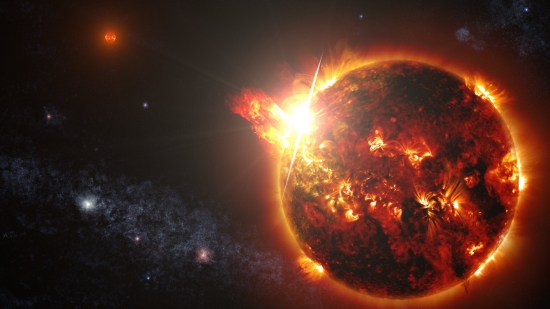
Image: An artistic rendering of a series of powerful stellar flares. Credit: NASA’s Goddard Space Flight Center/S. Wiessinger.
Published in Nature Astronomy, the research includes contributions from researchers at the University of Colorado at Boulder, the University of Chicago, Massachusetts Institute of Technology and NASA’s Nexus for Exoplanet System Science (NExSS).
Notice that we are increasingly studying exoplanet atmospheres in relation to space weather in the host star’s vicinity. Understanding how the signatures of chemical components vary with stellar activity like coronal mass ejections and flares — and in particular what the observational consequences may be — will help us shape the observing campaigns of future instruments, with consequences for detecting biosignatures.
The paper is Chen et al., “Persistence of flare-driven atmospheric chemistry on rocky habitable zone worlds,” Nature Astronomy 21 December 2020 (abstract).

A Transient at Proxima Centauri?
I see there’s now a Wikipedia page for BLC-1, the intriguing SETI detection made by Breakthrough Listen at the Parkes Observatory in Australia. The dataset in which the signal, found at 982 MHz, turned up comes from observations made in April and May of 2019, and it’s good to know that Breakthrough is working up two papers on the signal and subsequent analysis, given that the public face of the detection was originally in the form of a story leaked to the British newspaper The Guardian before the backup research was available.
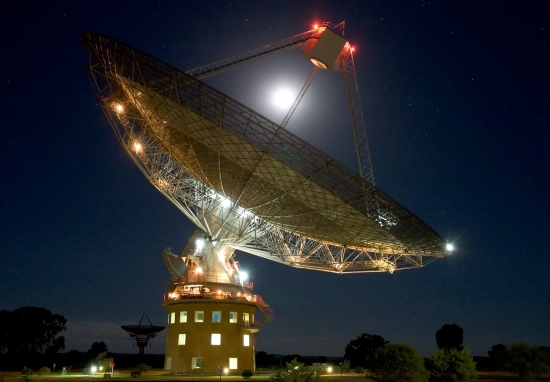
Image: CSIRO’s Parkes radio telescope in New South Wales, Australia. Credit: Shaun Amy.
The first thing to say about BLC-1 is that the acronym stands for Breakthrough Listen Candidate 1, marking the first time a signal has made it through to actual ‘candidate’ status after five years of observations, which is itself noteworthy given the intensity of the effort.
The second thing is that this is a transient, meaning it’s short-lived, and it hasn’t repeated. That gets us into tricky territory, for the SETI effort has detected numerous transients over the years, and the lack of repetition has made confirmation of their origin difficult if not impossible. The most famous is the Wow! signal detected at Ohio State in 1977, a signal that continues to inspire research, as we’re about to see in a new paper that considers some of its more unusual aspects. But more on that within a few weeks.
The BLC-1 transient may or may not be from Proxima Centauri, which is the reason for the question mark in the title. I say that because we can’t yet rule out terrestrial interference of some kind. But there are transients and there are transients, and this one does raise the eyebrows. Back in April of last year, Breakthrough was working with the Parkes instrument to study the flare activity at Proxima Centauri, a significant issue as we consider questions of habitability on planets around red dwarf stars because flares can compromise a planetary atmosphere.
The detection of BLC-1 within the Proxima data is credited to Shane Smith, an undergraduate at Hillsdale College (Michigan) working as an intern within the Breakthrough Listen project. Smith’s claim to fame should be air-tight if BLC-1 turns out to be the real deal.
We do know that the signal is narrow in bandwidth and vanished when the instrument looked away from Proxima Centauri. It contains no sign of modulation. The signal also showed some drift in frequency, which would be consistent with a source in motion; i.e., a planet orbiting a star. The intriguing habitable zone planet Proxima b has commanded attention as being an Earth-mass planet around the nearest star, and is often mentioned as a possible target for Breakthrough Starshot probes. But even the matter of drift is unusual, as Lee Billings and Jonathan O’Callaghan point out in an article in which they interviewed Breakthrough’s Sofia Sheikh (Penn State):
…the signal “drifts,” meaning that it appears to be changing very slightly in frequency—an effect that could be due to the motion of our planet, or of a moving extraterrestrial source such as a transmitter on the surface of one of Proxima Centauri’s worlds. But the drift is the reverse of what one would naively expect for a signal originating from a world twirling around our sun’s nearest neighboring star. “We would expect the signal to be going down in frequency like a trombone,” Sheikh says. “What we see instead is like a slide whistle—the frequency goes up.”
We’ve come a long way since November of 1967, when Jocelyn Bell Burnell discovered PSR B1919+21, the first radio pulsar, which was jokingly named LGM-1 (Little Green Men 1) by its discoverers. And why not? The signal seemed tight and remarkably regular.
While SETI has become far more visible since those days, we’ve seen how nature can mimic technology, but we’ve also learned that RFI – radio frequency interference – ranging from nearby transmitters to malfunctioning electronics, can get into the mix. Parkes had its ‘peryton’ bursts not so long ago, but they were traced back to problems with a nearby microwave oven.
A note on Y Combinator Hacker News last night (thanks for the tip, Steven Ward) points out that 982.000 MHz, for example, is also the wavelength of the Intel Stratix 10 FPGA, a field programmable gate array used for prototyping application-specific integrated circuits (ASICs). Several other hardware components listed there are also operating at this wavelength, a fact that Breakthrough’s analysts will doubtless be taking into account as they go through all the options for pinning this detection to terrestrial sources of RFI.
So we come back to the issue of transients and repetition. Thus far Breakthrough has subjected the BLC-1 signal to exhaustive analysis and no RFI has yet been identified. The work continues, valuable in and of itself because if this signal does turn out to be RFI, it will provide a way to fine-tune the existing Breakthrough algorithms to filter out such signals in the future.
And if we can’t find a plausible source of RFI? That would be interesting, to say the least, and we may be left with something like the Wow! signal, an intriguing but non-repeating source. I think we can say this: If it actually turns out that BLC-1 is the signature of an alien civilization, then we’ll be tempted to throw out the Fermi paradox (‘where are they?’), but also re-calibrate all our thinking about civilizations in the galaxy. After all, wouldn’t finding one around the star closest to the Sun imply we’re going to find them in great numbers almost wherever we look?
Maybe not. Who is it who said ‘the thing about aliens is that they’re alien?’ Meanwhile, we keep an eye on Proxima Centauri to see if this thing repeats.

JPL Work on a Gravitational Lensing Mission
Seeing oceans, continents and seasonal changes on an exoplanet pushes conventional optical instruments well beyond their limits, which is why NASA is exploring the Sun’s gravitational lens as a mission target in what is now the third phase of a study at NIAC (NASA Innovative Advanced Concepts). All of this builds upon the impressive achievements of Claudio Maccone that we’ve recently discussed. Led by Slava Turyshev, the NIAC effort takes advantage of light amplification of 1011 and angular resolutions that dwarf what the largest instruments in our catalog can deliver, showing what the right kind of space mission can do.
We’re going to track the Phase III work with great interest, but let’s look back at what the earlier studies have accomplished along the way. Specifically, I’m interested in mission architectures, even as the NASA effort at the Jet Propulsion Laboratory continues to consider the issues surrounding untangling an optical image from the Einstein ring around the Sun. Turyshev and team’s work thus far argues for the feasibility of such imaging, and as we begin Phase III, sees viewing an exoplanet image with a 25-kilometer surface resolution as a workable prospect.
But how to deliver a meter-class telescope to a staggeringly distant 550 AU? Consider that Voyager 1, launched in 1977, is now 152 AU out, with Voyager 2 at 126 AU. New Horizons is coming up on 50 AU from the Earth. We have to do better, and one way is to re-imagine how such a mission would be achieved through advances in key technologies and procedures.
Here we turn to mission enablers like solar sails, artificial intelligence and nano-satellites. We can even bring formation flying into a multi-spacecraft mix. A technology demonstration mission drawing on the NIAC work could fly within four years if we decide to fund it, pointing to a full-scale mission to the gravitational focus launched a decade later. Travel time is estimated at 20 years.
These are impressive numbers indeed, and I want to look at how Turyshev and team achieve them, but bear in mind that in parsing the Phase II report, we’re not studying a fixed mission proposal. This is a highly detailed research report that tackles every aspect of a gravitational lens mission, with multiple solutions examined from a variety of perspectives. One thing it emphatically brings home is how much research is needed in areas like sail materials and instrumentation for untangling lensed images. Directions for such research are sharply defined by the analysis, which will materially aid our progress moving into the Phase III effort.

Image: A meter-class telescope with a coronagraph to block solar light, placed in the strong interference region of the solar gravitational lens (SGL), is capable of imaging an exoplanet at a distance of up to 30 parsecs with a few 10 km-scale resolution on its surface. The picture shows results of a simulation of the effects of the SGL on an Earth-like exoplanet image. Left: original RGB color image with (1024×1024) pixels; center: image blurred by the SGL, sampled at an SNR of ~103 per color channel, or overall SNR of 3×103; right: the result of image deconvolution. Credit: Turyshev et al.
Modes of Propulsion
A mission to the Sun’s gravity lens need not be conceived as a single spacecraft. Turyshev relies on spacecraft of less than 100 kg (smallsats, in the report’s terminology) using solar sails, working together and produced in numbers that will enable the study of multiple targets.
The propulsive technique is a ‘Sundiver’ maneuver in which each smallsat spirals in toward perihelion in the range of 0.1 to 0.25 AU, achieving 15-25 AU per year exit velocity, which gets us to the gravity lensing region in less than 25 years. The sails are eventually ejected to reduce weight, and onboard propulsion (the study favors solar thermal) is available at cruise. The craft would enter the interstellar medium in 7 years as compared to Voyager’s 40, making the journey to the lens in a timeframe 2.5 times longer than what it took to get New Horizons to Pluto.
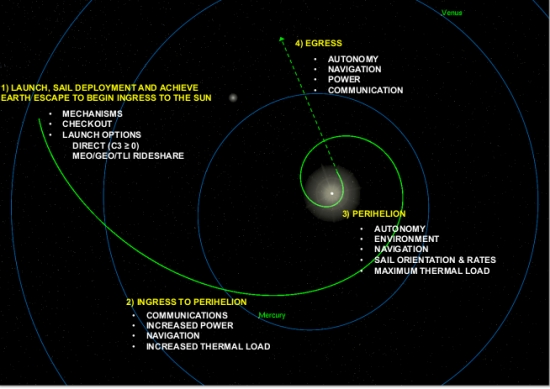
Image: Sailcraft example trajectory toward the Solar Gravity Lens. Credit: Turyshev et al.
The hybrid propulsion concept is necessary, and not just during cruise, because once in the focal lensing region, the spacecraft will need either chemical or electrical propulsion for navigation corrections and for operations and maintenance. Let’s pause on that point for a moment — Alex Tolley and I have been discussing this, and it shows up in the comments to the previous post. What Alex is interested in is whether there is in fact a ‘sweet spot’ where the problem of interference from the solar corona is maximally reduced compared to the loss of signal strength with distance. If there is, how do we maximize our stay in it?
Recall that while the focal line goes to infinity, the signal gain for FOCAL is proportional to the distance. A closer position gives you stronger signal intensity. Our craft will not only need to make course corrections as needed to keep on line with the target star, but may slow using onboard propulsion to remain in this maximally effective area longer. I ran this past Claudio Maccone, who responded that simulations on these matters are needed and will doubtless be part of the Phase II analysis. He has tackled the problem in some detail already:
“For instance: we do NOT have any reliable mathematical model of the Solar Corona, since the Corona keeps changing in an unpredictable way all the time.
“In my 2009 book I devoted the whole Chapters 8 and 9 to use THREE different Coronal Models just to find HOW MUCH the TRUE FOCUS is PUSHED beyond 550 AU because of the DIVERGENT LENS EFFECT created by the electrons in the lowest level of the Corona. For instance, if the frequency of the electromagnetic waves is the Peak Frequency of the Planckian CMB, then I found that the TRUE FOCUS is 763 AU Away from the Sun, rather than just 550 AU.
“My bottom-line suggestion is to let FOCAL observe HIGH Frequencies, like 160 GHz, that are NOT pushing the true focus too much beyond 550 AU.”
Where we make our best observations and how we keep our spacecraft in position are questions that highlight the need for the onboard propulsion assumed by the Phase II study.
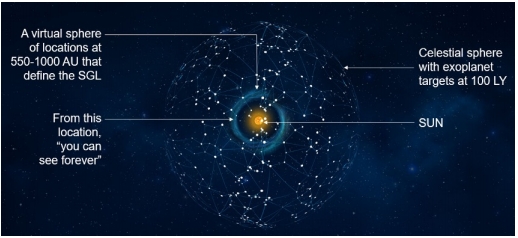
Image: Our stellar neighborhood with notional targets. Credit: Turyshev et al.
For maximum velocity in the maneuver at the Sun, as close a perihelion as possible is demanded, which calls for a sailcraft design that can withstand the high levels of heat and radiation. That in turn points to the needed laboratory and flight testing of sail materials proposed for further study in the NIAC work. Let me quote from the report on this:
Interplanetary smallsats are still to be developed – the recent success of MarCO brings them perhaps to TRL 7. Solar sails have now flown – IKAROS and LightSail-2 already mentioned, and NASA is preparing to fly NEA-Scout. Scaling sails to be thinner and using materials to withstand higher temperatures near the Sun remains to be done. As mentioned above, we propose to do this in a technology test flight to the aforementioned 0.3 AU with an exit velocity ~6 AU/year. This would still be the fastest spacecraft ever flown.
The report goes on to analyze a technology demonstration mission that could be done within a few years at a cost less than $40 million, using a ‘rideshare’ launch to approximately GEO.
String of Pearls
The mission concept calls for an array of optical telescopes to be launched to the gravity lensing region. I’ll adopt the Turyshev acronym of SGL for this — Solar Gravity Lens. The thinking is that multiple small satellites can be launched in a ‘string of pearls’ architecture, where each ‘pearl’ is an ensemble of smallsats, with multiple such ensembles periodically launched. A series of these pearls, multiple smallsats operating interdependently using AI technologies, provides communications relays, observational redundancy and data management for the mission. From the report:
By launching these pearls on an approximately annual basis, we create the “string”, with pearls spaced along the string some 20-25 AU apart throughout the timeline of the mission. So that later pearls have the opportunity to incorporate the latest advancements in technology for improved capability, reliability, and/or reductions in size/weigh/power which could translate to further cost savings.
In other words, rather than being a one-off mission in which a single spacecraft studies a single target, the SGL study conceives of a flexible investigation of multiple exoplanetary systems, with ‘strings of pearls’ launched toward a variety of areas within the focus within which exoplanet targets can be observed. Whereas the Phase I NIAC study analyzed instrument and mission requirements and demonstrated the feasibility of imaging, the Phase II study refines the mission architecture and makes the case that a gravity lens mission, while challenging, is possible with technologies that are already available or have reached a high degree of maturity.
Notice the unusual solar sail design — called SunVane — that was originally developed at the space technology company L’Garde. Here we’re looking at a sail design based on square panels aligned along a truss to provide the needed sail area. In the Phase II study, the craft would achieve 25 AU/year, reaching 600 AU in ~26 years (allowing two years for inner system approach to the Sun). [Note: I’ve replaced the earlier SunVane image with this latest concept, as passed along by Xplore’s Darren Garber. Xplore contributed the design for the demonstration mission’s solar sail].
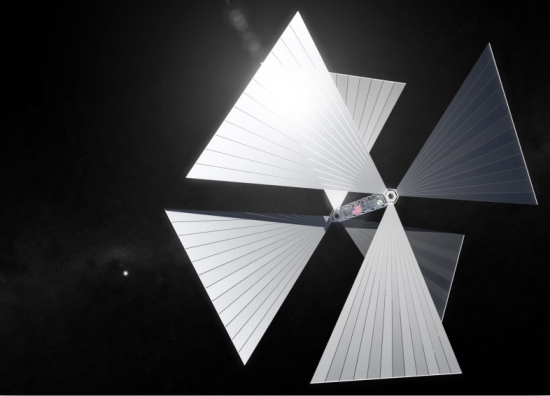
Image: The SunVane concept. Credit: Darren D. Garber (Xplore, Inc).
The report examines a sail area of 45,000 m2, equivalent to a ~212×212 m2 sail, with spacecraft components to be configured along the truss. Deployment issues are minimal with the SunVane design. The vanes are kept aligned edge-on to the Sun as the craft approaches perihelion, then directed face-on to promote maximum acceleration.
We have to learn how to adjust parameters for the sail to allow the highest possible velocity, with areal density A/m being critical — here A stands for the area in square meters of the sail, with m as the total mass of the sailcraft in kilograms (this includes spacecraft plus sail). Sail materials and their temperature properties will be crucial in determining the perihelion distance that can be achieved. This calls for laboratory and flight testing of sail material as part of the continuing research moving into the Phase III study and beyond. Sail size is a key issue:
The challenge for design of a solar sail is managing its size – large dimensions lead to unstable dynamics and difficult deployment. In this study we have consider[ed] a range of smallsat masses (<100 kg) and some of the tradeoffs of sail materials (defining perihelion distance) and sail area (defining the A/m and hence the exit velocity…). As an example, for the SGLF mission, consider perihelion distance of 0.1 AU (20Rsun) and A/m=900 m2/kg; the exit velocity would be 25 AU/year, reaching 600 AU in ~26 years (allowing 2 years for inner solar system approach to the Sun). The resulting sail area is 45,000 m2, equivalent to a ~212×212 m2 sail.
The size of that number provokes the decision to explore the SunVane concept, which distributes sail area in a way that allows spacecraft components to be placed along the truss instead of being confined to the sail’s center of gravity, and which has the added benefit of high maneuverability. A low-cost near-term test flight is proposed with testing of sail material and control, closing to a perihelion in the range of 0.3 AU, with an escape velocity from the Solar System of 6-7 AU per year. Several such spacecraft would enable a test of swarm architectures.
Thus the concept: Multiple spacecraft would be launched together as an ensemble — the ‘pearl’ — using solar sails deployed on each and navigating through the Deep Space Network, with the spacecraft maintaining a separation on the order of 15,000 km as they pass through perihelion. Such ensembles are periodically launched, acting interdependently in ways that would maximize flexibility while reducing risk from a single catastrophic failure and lowering mission cost. We wind up with a system that would enable investigations of multiple extrasolar systems.
I haven’t had time to get into such issues as communications and power for the individual smallsats, or data processing and AI, all matters that are covered in the report, nor have I looked in as much detail as I would have liked at the sail arrays, envisioned through SunVane as on the order of 16 vanes of 103 m2, allowing the area necessary in a configuration the report considers realistic. This is a lengthy, rich document, and I commend it to those wanting to dig further into all these matters.
The report is Turyshev et al., “Direct Multipixel Imaging and Spectroscopy of an Exoplanet with a Solar Gravity Lens Mission,” Final Report NASA Innovative Advanced Concepts Phase II (full text).

The FOCAL Radio Bridge
Getting a probe to another star is a big enough problem, but woven inextricably through it is the issue of communications. Adding payload steepens the propulsion curve in dramatic fashion, which is why recent thinking has dwelled so firmly on miniaturizing the spacecraft. Thus Breakthrough Starshot, which envisions payloads roughly on the order of a computer chip. No wonder, with spacecraft of that size, getting data back to Earth is such a daunting challenge.
Can gravitational lensing help? We’ve seen that the Sun’s mass shapes spacetime around it, bending light from targets on the other side so that electromagnetic waves come to a focal point about 550 AU out. The implications for imaging are under intense study at the Jet Propulsion Laboratory, where Slava Turyshev’s team, working with a Phase III NIAC grant, is exploring “Direct Multipixel Imaging and Spectroscopy of an Exoplanet with a Solar Gravitational Lens Mission,” taking two prior studies, a Phase I and II at NIAC, forward in terms of imaging.
But if we can fight off solar corona effects and achieve a signal-to-noise ratio high enough — Turyshev believes this is possible — we might do more than reconstructing an exoplanet image with 25-kilometer scale surface resolution. Such an image would help us understand the target for future interstellar probes, but Claudio Maccone has been writing about using the same lensing effect to boost communications in dramatic fashion. And if Starshot’s payloads might have little more than a cellphone’s available power, such levels might prove workable.
The Gravitational Lens as Relay
How is this possible? There are a lot of issues here, but we can start with Bit Error Rate, which has to do with the quality of a signal. Specifically, BER is the number of erroneous bits received divided by the total number of bits transmitted. We can compare the Bit Error Rate across interstellar distances with and without the gravitational lens effect, as Maccone first did in a 2011 paper. I’m going to use that paper and his recent presentation to examine the results and what they mean for current thinking about missions.
Before we start miniaturizing, let’s assume a probe at Alpha Centauri communicating to Earth using a 12-meter antenna, a fairly conventional spacecraft working with a Deep Space Network-class antenna (a 70-meter dish) on the other end, trying to communicate over the Ka band (32 GHz), with a bit rate of 32 kpbs. These assumptions come from recent missions: The Ka band is the highest frequency used by Cassini, while the 32 kbps bit rate equals that of ESA’s Rosetta spacecraft. Maccone then goes on to assume transmitting power of 40 W.
The paper (citation below) is available in full text, so there is no need to go through the chain of reasoning in detail here. The point is that the signal is shown to be unusable. But matters change if we deploy a FOCAL mission to the Sun’s gravity lens. According to the paper’s equations, the same equipment now allows received power and acceptable Bit Error Rate at Alpha Centauri. Thus the figure below, which Maccone used in his online talk.
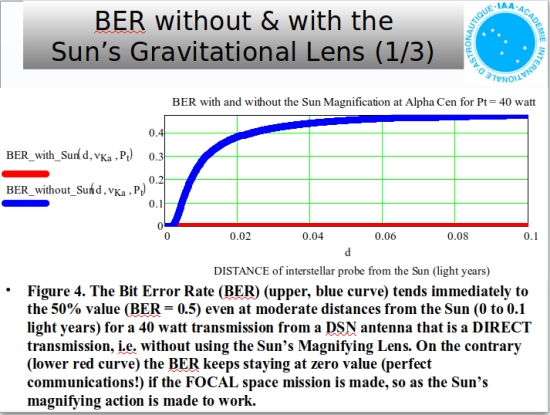
If we follow the equations through, we don’t begin to introduce significant errors until we’re fully 9 light years out, not far off the distance to Epsilon Eridani. By the time we get to a probe at a distance of 100 light years, we reach a level of Bit Error Rate high enough to swamp the dataflow with this equipment. A spacecraft using the Sun’s gravitational lens, then, can communicate effectively assuming present-day power levels and infrastructure with a probe at Alpha Centauri, making the target of 550 AU an enabler for data return from small payloads.
If Breakthrough Starshot had a gravitational lens relay of this kind, the daunting communications issue would be cast in a new light. Just how complicated communications matters are without a gravity lens relay is something I’ll soon explore with a look at the just released Request for Proposals from Breakthrough that deals explicitly with the question.
Enter the Radio Bridge
What is it that S.R. Hadden says in the film Contact? “The first rule of government spending: why build one, when you can build two, at twice the price?” This is where Claudio Maccone is suggesting a forward path for interstellar probes that looks at what we do next after our initial interstellar probes fly past their target. The Starshot model, for example, assumes a fleet of sail-driven craft flung past a nearby star like Proxima Centauri to collect and return an image of the planets there. This is a flyby concept. A few hours in-system and gone.
Flybys are first steps and, as New Horizons has recently shown so dramatically (not to mention a host of other craft, like Voyager in the past), we can collect invaluable data from them. But once we’ve achieved flybys around nearby stars, we’ll want to continue our explorations by establishing a robotic (or one day human, perhaps) presence there. Now we would like not just the relatively slow communications methods enabled by the gravitational lens of the Sun but a much faster capability. We achieve this by using a second lens, the one near our target star.
If we’re talking about a mission to Alpha Centauri, then we go to the gravitational lens of Centauri A because it has the highest mass of the three stars, and thus offers the highest gain. Here the FOCAL spacecraft would be placed at a minimum distance of 750 AU for communications and data retrieval from targets around any one of the three stars. We have a radio bridge with communications capabilities that can be achieved by no other means. Here is the image Maccone uses to illustrate the point, along with his own caption from the paper.
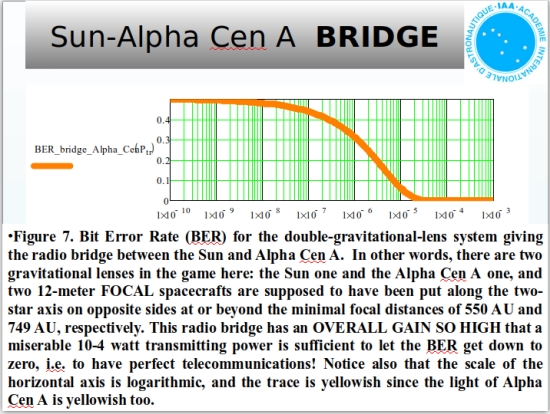
If we establish the radio bridge, our capabilities at error-free communications between the Sun and Alpha Centauri, assuming two 12-meter FOCAL antennae, become striking: The minimum transmitted power falls to 10-4 watts. One-tenth of a milliwatt does the job, creating error-free communications between spacecraft and Earth, meaning we have created a workable channel for future activities in the Alpha Centauri system, whether human or robotic.
To make it happen, an initial FOCAL mission becomes our communications relay, while a second FOCAL mission creates the radio bridge. Multiple human generations may separate the two projects; this is not a task for the impatient. But should we see it through, huge, power hungry communications systems aboard the spacecraft are not necessary, while communications with our growing infrastructure around nearby stars become robust and all but routine.
Building radio bridges is a huge challenge, assuming not only the capability of reaching and exploiting the Solar gravity lens, but eventually reaching another star not just with a flyby but with a craft capable of decelerating into the target system and positioning itself into the focal lens of the star there. The sequence may be straightforward: Use our Sun’s gravity lens to communicate with the first interstellar probes, then expand capability by setting up the second communications relay. But the implementation, like everything interstellar, pushes all our limits well beyond anything we have yet achieved. Which is why I love writing about all this.
Technologies both suggest and enable new uses that push beyond the currently possible. If there is one thing my continuing dreams of Alpha Centauri have taught me, it’s that thinking beyond our own personal limitations builds the groundwork for future generations.
The idea that we should think only of what we as individuals will benefit from misses the point of intellectual inquiry, and blunts the blade of discovery. So I applaud the efforts of those currently working the hard equations of reaching 550 AU, even though many of them will probably not see such a mission arrive. Being a part of the effort, emplacing cornerstones, is what counts.
The paper is Maccone, “Interstellar Radio Links Enhanced by Exploiting the Sun as a Gravitational Lens,” Acta Astronautica Vol. 68, Issues 1-2 (January-February 2011), pp. 76-84 (abstract/full text).

Developing FOCAL Mission Concepts
In the early summer of 2005, I found myself, thanks to the efforts of Greg Matloff and Princeton’s Ed Belbruno, in Princeton for a conference called New Trends in Astrodynamics and Applications II, which Dr. Belbruno had organized. I was to give a brief talk at the end of the session summarizing what was going on in the interstellar travel community. Two days of chill rain didn’t dampen my enthusiasm at seeing Greg and his wife, the artist C Bangs, as well as Belbruno himself, who had been a great help as I put together my Centauri Dreams book. And on the morning of the first day of the conference, I joined Greg, C and Claudio Maccone for breakfast at the Nassau Inn, Princeton’s lovely colonial era hostelry.
I’ve since had the opportunity to talk with Dr. Maccone many times at conferences, and one year enjoyed memorable meals with him in the Italian Alps, but that first encounter really sticks in my mind. I had been thinking about gravitational lensing for several years, but it was only through studying Maccone’s writings that I began to fathom what the idea represented. Suddenly I found myself having breakfast with the man who had made a mission to the Sun’s gravitational lens a cornerstone of his professional life. What a way to start the Princeton conference!
Here was an opportunity offered up by nature to achieve extraordinary magnifications. It would be a natural lensing available to any civilization that could reach the gravity focus of its star, which for the Sun means about 550 AU. As the focal line extends to infinity, studies at various wavelengths are enabled as the spacecraft continues its departure from the Solar System.
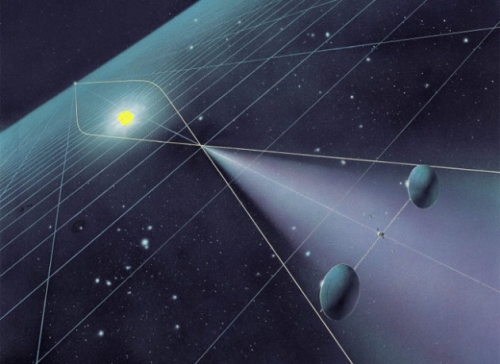
Image: The FOCAL mission as described by Claudio Maccone in his 2009 book Deep Space Flight and Communications (Springer).
Let’s dwell on that a moment. The goal in a mission to the gravitational lens — Maccone calls the concept FOCAL, which is what I will use as we talk about the topic in the next few days — would not be to reach 550 AU and stay there. The gravitational focus is not like an optical lens, where light diverges after the focus. Instead, as light from the other side of the Sun is focused by the Sun’s gravitational field, it remains fixed along the focal axis. Every point along the straight line trajectory beyond 550 AU remains a focal point.
So if you want to image a target, you move toward 550 AU precisely opposite to the target you want to image, putting the Sun between you and it. Think Alpha Centauri, for example, where a close look at Proxima Centauri b would be exceedingly useful as projects like Breakthrough Starshot ponder sending probes there. The gain for optical radiation from the planet would be amplified by a factor of 1011. Now think of the uses not just in imaging but in astronomy at a wide range of wavelengths. FOCAL would be a true interstellar precursor.
Assuming, of course, that you could untangle the image. The planet we want to study is, after all, spread out into an Einstein ring surrounding the Sun. More on this in a moment.
Beyond imaging, the communications potential for the gravity lens is intriguing and enabling. I’ll pause to note that the history of gravitational lens mission ideas even includes a SETI aspect. Back in the 1990s, drawing on work at the Italian aerospace company Alenia Spazio, Greg Matloff examined an inflatable radio telescope called Quasat, which became the subject of regular meetings in that decade. All this ties in with the extensive Italian investigation of solar sail ideas that I’ve discussed before in these pages, work informed by the efforts of physicists like Giovanni Vulpetti, Maccone himself, Giancarlo Genta, and the continuing work of Matloff.
Matloff explored solar sailing to reach the gravitational focus in a 1994 paper (“Solar Sailing for Radio Astronomy and SETI: An Extrasolar Mission to 550 AU,” Journal of the British Interplanetary Society Vol. 47, pp. 476-484), where sails enabled placement of a probe at the gravity lens whose observations ranged through radio astronomy and into SETI.
I mentioned Von Eshleman’s work back in the 1970s, which to my knowledge was the first time anyone proposed an actual mission to 550 AU and beyond to study the Sun’s gravitational lens. It took just over a decade for the concept to take deep root and spawn a mission concept.
For it was in 1992 that Claudio Maccone began discussing a FOCAL mission at a conference in Torino, and in 1993 he went on to submit a formal proposal to the European Space Agency for the funding needed to firm up a mission design. Meanwhile, he was identifying issues that needed to be addressed. The 550 AU distance may be a bare minimum, given the problem of distortion caused by the Sun’s corona. But the farther the probe travels from the Sun, the less the coronal effect, and with a focal line extending to infinity, we have room to maneuver.
A FOCAL mission is quite an interesting problem for spacecraft design, one that Maccone subsequently addressed in his Deep Space Flight and Communications (Springer, 2009). There he advocated using tethers to deploy two antennae, each tether several kilometers in length, allowing a larger, more detailed field of view than one provided by a single antenna. If these methods work, we still have a very difficult image to untangle. Potentially, we could look at details on a planetary surface even at the distance of Proxima b, studying these with a mission that is 278 times closer than the actual distance to the target. But about that image…
Geoffrey Landis has analyzed the problems we’ll face in using the Sun as a ‘gravitational telescope’ when trying to image the surface of an exoplanet. The issues are manifold, and include pointing and focal length at these magnifications, signal-to-noise ratio involving the Sun’s corona, and what he calls ‘focal blur,’ which seems inherent in the nature of gravitational lensing. All of this in a significant paper titled “Mission to the Gravitational Focus of the Sun: A Critical Analysis,” which addresses matters that are also being examined in NASA’s latest NIAC study. JPL’s Slava Turyshev is principal investigator on that one, an unusual Phase III grant called “Direct Multipixel Imaging and Spectroscopy of an Exoplanet with a Solar Gravitational Lens Mission.” The concept has already gone through two prior rounds of development.
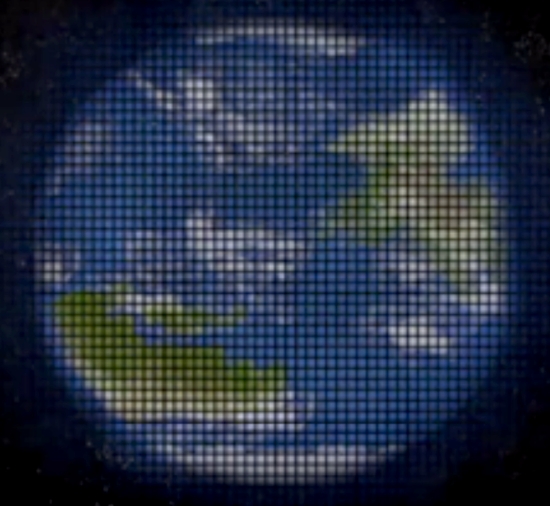
Image: Artist’s depiction of a possible image from a Solar Gravitational Lens (SGL) telescope. Credit: Slava Turyshev.
But I’m getting ahead of myself, and deep into unknowns under current investigation. Let’s talk in the next post, then, about using the gravitational lens for communications. It’s a fascinating option for efforts like Breakthrough Starshot, in which getting a signal back to Earth from tiny payloads is an obvious concern. Just what, then, is a radio bridge, and how does Claudio Maccone hope to use one to put a significantly different spin on missions like Starshot? I’ll also have thoughts on the NASA effort and the continuing mission design within NIAC.
Note: Geoffrey Landis also presented a later version of his work on the lens in a 2017 conference paper for the Tennessee Valley Interstellar Workshop, “A Telescope at the Solar Gravitational Lens: Problems and Solutions” (full text). This paper, along with another by Slava Turyshev on imaging issues, is also available in the conference’s proceedings volume.

